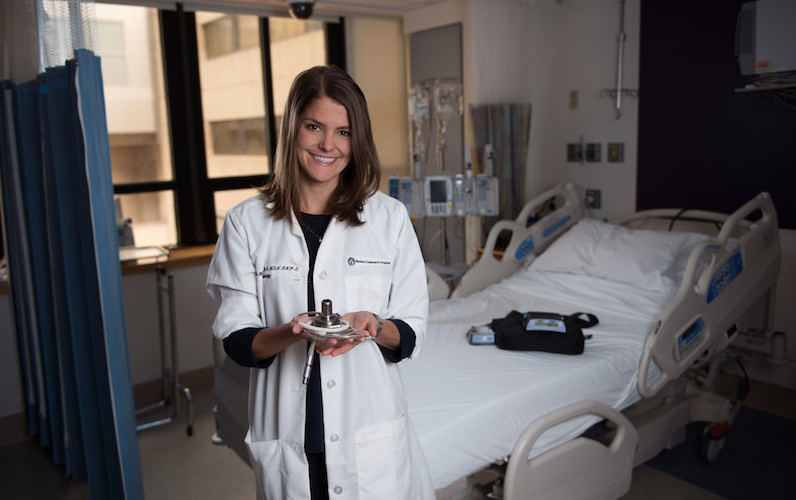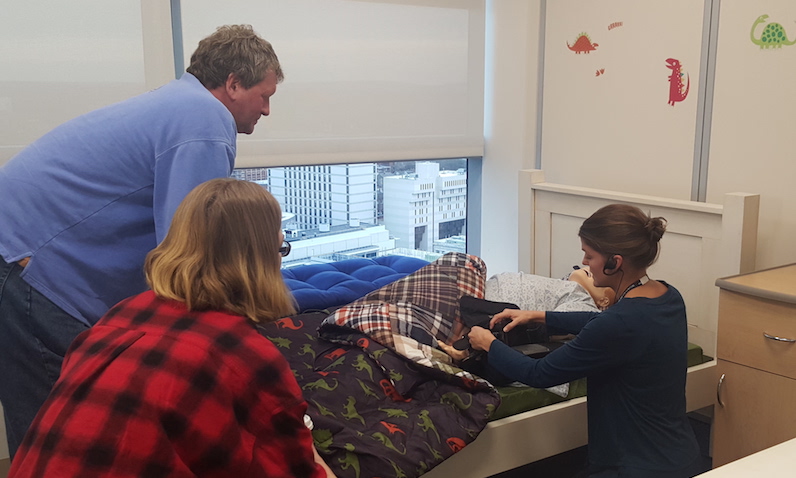
Children who are candidates for heart transplant sometimes have a ventricular assist device (VAD) implanted in their chest to support them while they wait for a new heart. VADs are electrically-powered heart pumps that can also be implanted long term if a child is ineligible for transplant, or temporarily to buy children time to recover their own heart function.
Originally used only in the hospital, implanted VADs have gone home with children since 2012. Because problems with VADs can be life-threatening, families need extensive training in managing the device and its external controller at home. Nurse practitioner Beth Hawkins RN, MSN, FNP-C, and her colleagues in the Boston Children’s VAD Program begin the training at the bedside when the child is still in the cardiac ICU.
But despite lectures, demos and practice opportunities, the prospect of maintaining a VAD is terrifying for many parents and children.
“A lot of families feel their child is attached to a ticking time bomb,” says Hawkins. “Many say taking a child home on a VAD feels like having a newborn baby again.”
Hawkins realized that families needed more support. Working closely with Christina VanderPluym, MD, medical director of the VAD Program, and fellow nurse practititioner Courtney Ventresco, NP, she’s leading two projects. One is a VADKids app that allows patients and parents to communicate with the VAD team, access educational information and log vital signs.
The other project, a partnership with Boston Children’s Simulator Program (SIMPeds), allows families to take part in lifelike “dress rehearsals” with the VAD to boost their confidence.
Rehearsing the common and the scary

Using child- or adolescent-sized mannequins in a room set up like a child’s home bedroom, parents can practice both routine responsibilities and managing difficult situations. Simulation scenarios include:
- changing the sterile dressing on the line connecting the VAD with the controller
- managing a fainting episode
- measuring the child’s mean arterial blood pressure with a Doppler machine
- replacing the VAD’s controller with a backup
- packing a “Go Bag” for excursions, with backup batteries, a backup controller and emergency contact information.
“We made the mannequins as realistic as possible,” says Hawkins. “We even recorded the hum of the VAD device and put it in the mannequin’s chest.”
Bringing in emotion
The mannequins also talk, voiced by SIMPeds staff or often Hawkins herself, in a nearby control room. This ramps up the emotional intensity of the simulations.
“It’s easy to change out a battery in a conference room where it’s quiet, but it’s different when your daughter’s saying, ‘Hurry up, I have to pee!’ or ‘I don’t want to get up!’” says Hawkins. “Because I know the patients, I can say things that I know their children would say to make the scenarios more realistic.”
In one scenario, the VAD’s external power sources both come unplugged, causing the device to stop. Parents hear an alarm and have to recognize the blank screen on the VAD controller, figure out that it’s unplugged, then dig under the “child’s” blankets, find the electrical cord and plug the controller back into a power source. All the while, the “child” is saying, “I don’t feel good! My chest feels funny!” “Why is the alarm going off — make it stop!”
Developing a VAD curriculum
Two families have participated in the simulations to date. Hawkins and her colleagues created them based on learning gaps they’ve observed and actual emergencies families have dealt with. She and the VAD team went through initial simulations themselves, with actors playing the parents.
“The actors gave us feedback on what worked or didn’t work and what helped reassure them and make them feel confident,” Hawkins says.
One prior patient told them that seeing his mom fumble and not know what to do during the scenarios would make him anxious. For that reason, parents go through the scenarios first, before the child or adolescent.
One mother worried that her child might need CPR, so a future simulation will allow parents to practice that emergency scenario. Other scenarios can be developed as needed.
“We want to empower family caregivers with the tools and the confidence to deal with whatever might come up, so they’re not anxious when they leave the hospital,” says Hawkins.
Going home with a VAD? There’s an app for that
Boston VADKids® is a home-monitoring app for smartphone, tablet or computer that enables older children and adolescents to track their vital signs, get information on their VAD and stay in touch daily with the Boston Children’s VAD team. “They can securely text us messages and pictures, access emergency information and log their VAD’s daily information to send to us,” says Hawkins.
Kids can choose to include or exclude their parents on the communications. Their input information is reviewed daily by a VAD team member and integrated into their electronic medical record. Texts are monitored 24/7, and emails notify the team of any measurements that fall outside the normal range. Hawkins and colleagues can then text back secure messages like, “Your INR [a measure of clotting tendency] today was 2.5, please take 5 mg of Coumadin tonight and retest in 1 week.”
